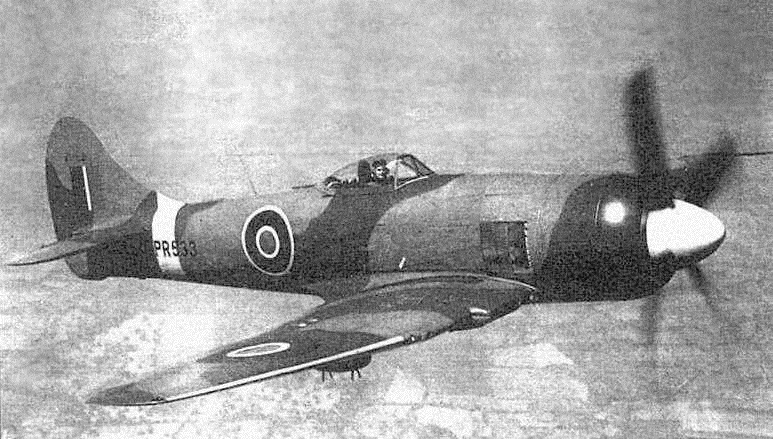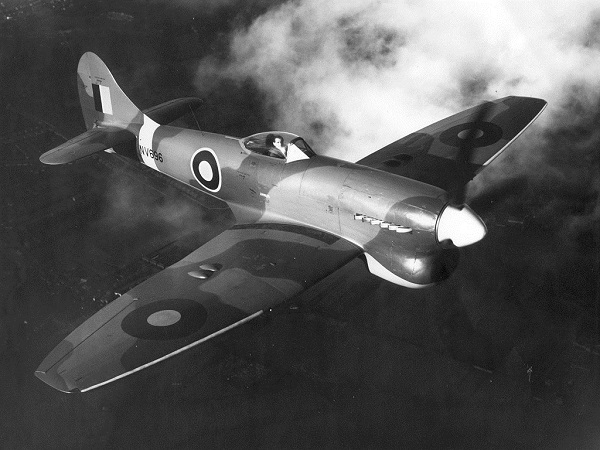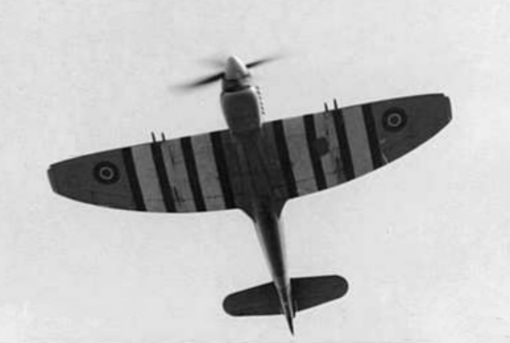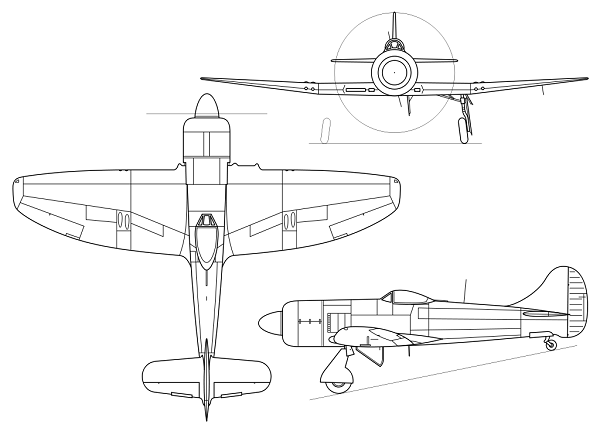

The Hawker Tempest is a British fighter aircraft primarily used by the Royal Air Force (RAF) in the Second World War. The Tempest, originally known as the Typhoon II, was an improved derivative of the Hawker Typhoon, intended to address the Typhoon's unexpected fall-off of performance at high altitude by replacing its wing with a thinner laminar flow design. Having diverged considerably from the Typhoon, it was chosen to rename the aircraft Tempest. The Tempest emerged as one of the most powerful fighters of World War II and was the fastest single-engine propeller-driven aircraft of the war at low altitude.[2]

Upon entering service in 1944, the Tempest was used as a low-level interceptor, particularly against the V-1 flying bomb threat, and as a ground attack platform, in which it supported major events such as Operation Market Garden. Later, it successfully targeted the rail infrastructure in Germany and Luftwaffe aircraft on the ground, as well as countering such attacks by German fighters. The Tempest was effective in the low-level interception role, including against newly developed jet-propelled aircraft such as the Messerschmitt Me 262.

The further-developed Tempest Mk.II did not enter service until after the end of hostilities. It had several improvements, including being tropicalised for combat against Japan in South-East Asia as part of the Commonwealth Tiger Force.
Read more
Crew: 1
Length: 33 ft 8 in (10.26 m)
Tempest II: 34 ft 5 in (10.49 m)
Wingspan: 41 ft 0 in (12.50 m)
Height: 14 ft 10 in (4.52 m) (tail in rigging position with one propeller blade vertical) ; 16 ft 1 in (4.90 m) (tail down with one propeller blade vertical)
Tempest II: 13 ft 6 in (4.11 m) (tail in rigging position with one propeller blade vertical) ; 14 ft 6 in (4.42 m) (tail down with one propeller blade vertical)
Wing area: 302 sq ft (28.1 m2)
Airfoil: root:Hawker H.14/14/37.5 ; tip:Hawker H.14/10/37.5 (maximum thickness at 37.5% chord)
Gross weight: 11,400 lb (5,171 kg) (interceptor) ; 12,500 lb (5,700 kg) (fighter-bomber: 2x 500 lb (230 kg) bombs) ; 13,500 lb (6,100 kg) (fighter-bomber: 2x 1,000 lb (450 kg) bombs)
Tempest II: 11,800 lb (5,400 kg) (interceptor) ; 12,800 lb (5,800 kg) (fighter-bomber: 2x 500 lb (230 kg) bombs) ; 13,800 lb (6,300 kg) (fighter-bomber: 2x 1,000 lb (450 kg) bombs
Tempest VI: 12,000 lb (5,400 kg) (interceptor)
Fuel capacity: 100/130 Octane 160 imp gal (190 US gal; 730 l) internal + 90 imp gal (110 US gal; 410 l) or 180 imp gal (220 US gal; 820 l) in two auxiliary drop tanks under the wings
Oil tank capacity: 16 imp gal (19 US gal; 73 l)
Tempest II: 14 imp gal (17 US gal; 64 l)
Tempest VI: 22 imp gal (26 US gal; 100 l)
Powerplant: 1 × Napier Sabre IIB H-24 liquid-cooled sleeve-valve piston engine, 2,420 hp (1,800 kW) at + 11 lb boost for 5 minutes at sea level[nb 13] ; 2,010 hp (1,500 kW) for take-off ; 2,045 hp (1,525 kW) at 13,750 ft (4,190 m)
Tempest II: Bristol Centaurus V 2,530 hp (1,890 kW) for 5 minutes at sea level
Tempest VI: Napier Sabre V 2,420 hp (1,800 kW) for 5 minutes at sea level
Propellers: 4-bladed de Havilland Hydromatic, 14 ft (4.3 m) diameter constant-speed propeller
Tempest II: Rotol 12 ft 9 in (3.89 m) diameter 4-bladed constant-speed propeller
Maximum speed: 435 mph (700 km/h; 378 kn) at 17,000 ft (5,200 m) ; 390 mph (340 kn; 630 km/h) at sea level
Tempest II: 440 mph (380 kn; 710 km/h) at 17,000 ft (5,200 m) ; 410 mph (360 kn; 660 km/h) at 29,000 ft (8,800 m) ; 400.6 mph (348.1 kn; 644.7 km/h) at sea level
Tempest VI: 450 mph (390 kn; 720 km/h) at 14,500 ft (4,400 m) ; 425 mph (369 kn; 684 km/h) at 30,000 ft (9,100 m) ; 395 mph (343 kn; 636 km/h) at sea level
Combat range: 420 mi (365 nmi; 676 km) Tempest II with 250 imp gal (300 US gal; 1,100 l) fuel, climb, 15 minutes combat and RTB with 20% reserve
Service ceiling: 36,500 ft (11,100 m)
Rate of climb: 4,700 ft/min (24 m/s)
Time to altitude: 20,000 ft (6,100 m) in 6 minutes at combat power
Tempest II: 20,000 ft (6,100 m) in 5 minutes at combat power
Tempest VI: 20,000 ft (6,100 m) in 4 minutes 45 seconds at combat power
Wing loading: 44.7 lb/sq ft (218 kg/m2) at 13,500 lb (6,100 kg)
Power/mass: 6.7 lb/hp (4.1 kg/kW) at 13,500 lb (6,100 kg)
Tempest II: 5.1 lb/hp (3.1 kg/kW) at 13,300 lb (6,000 kg)
Tempest VI: 5.2 lb/hp (3.2 kg/kW) at 12,000 lb (5,400 kg)
4 × 20 mm (0.787 in) Mark II Hispano cannon, 200 rpg. Later models used Mark V Hispano Cannon.
2 × 500 lb (230 kg) or 1,000 lb (450 kg) bombs
8 × 3 in (76.20 mm) RP-3 rockets (post-Second World War)
Provision for 2 × 45 imp gal (54 US gal; 200 l) or 2 × 90 imp gal (110 US gal; 410 l) drop tanks.



